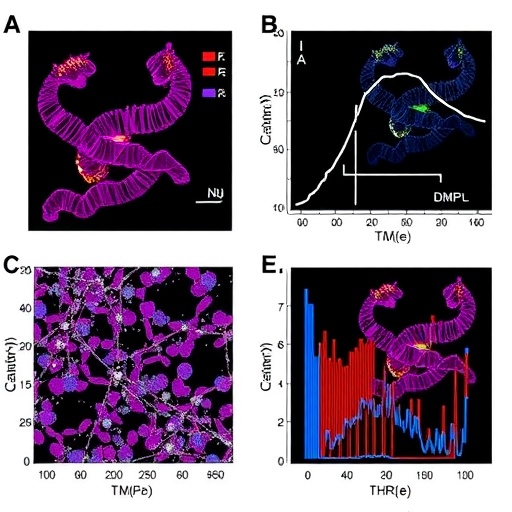PROTECT YOUR DNA WITH QUANTUM TECHNOLOGY
Orgo-Life the new way to the future Advertising by AdpathwayIn a groundbreaking study poised to reshape our understanding of mitochondrial metabolism, researchers have unveiled the crucial roles of two enigmatic transporters, SLC25A42 and SLC25A16, in the import and handling of coenzyme A (CoA) within mitochondria. The meticulous work, recently published in Nature Metabolism, deploys an innovative pan-chain acyl-CoA profiling technique that exposes a previously elusive dimension of cellular biochemistry. This research illuminates the intricate choreography of CoA trafficking, a fundamental process underpinning mitochondrial function and cellular energy homeostasis, with profound implications for the comprehension of metabolic diseases and mitochondrial pathologies.
Mitochondria, often dubbed the powerhouses of the cell, rely on a sophisticated network of metabolites and cofactors to drive oxidative phosphorylation and energy generation. Central to these processes is coenzyme A, a multifaceted cofactor facilitating acyl group transfer reactions essential for fatty acid oxidation, the tricarboxylic acid (TCA) cycle, and numerous biosynthetic pathways. Despite CoA’s significance, the mechanisms by which it is transported into mitochondria—a compartment separated from the cytoplasm by a highly selective double membrane—have remained largely enigmatic. The identification and functional elucidation of SLC25A42 and SLC25A16 as mitochondrial CoA importers mark a transformational advance in mitochondrial biology.
The research team employed an innovative cellular profiling platform capable of quantifying a comprehensive spectrum of acyl-CoA species across subcellular compartments. This pan-chain acyl-CoA profiling offers unprecedented resolution into the dynamic distribution and utilization of CoA and its derivatives within cells. By integrating metabolomic data with genetic perturbations and biochemical assays, the authors systematically demonstrated that SLC25A42 and SLC25A16 are indispensable for steady-state mitochondrial CoA levels and for sustaining metabolic flux through key mitochondrial pathways.
SLC25A42, previously a relatively uncharacterized member of the solute carrier family 25 (SLC25), was revealed as a primary transporter responsible for importing CoA into the mitochondrial matrix. This transporter exhibits substrate specificity and kinetic properties tailored to facilitate efficient CoA translocation against intracellular concentration gradients. Similarly, SLC25A16 was shown to have a complementary role, potentially mediating the exchange or transport of acylated CoA derivatives, thereby ensuring the versatility of mitochondrial acyl-CoA pools necessary for diverse metabolic processes.
The implications of these findings are multifold. By elucidating the pathways controlling mitochondrial CoA homeostasis, the study provides vital insights into the pathophysiology of metabolic disorders linked to mitochondrial dysfunction, such as neurodegenerative diseases, inherited mitochondrial syndromes, and metabolic syndromes including diabetes and obesity. Disruptions in CoA metabolism may produce cascading effects on energy production, lipid metabolism, and redox balance, highlighting the therapeutic potential of targeting SLC25A42 and SLC25A16 or their regulatory networks.
A striking facet of the study is its methodological innovation. The pan-chain acyl-CoA profiling method applies advanced mass spectrometry coupled with subcellular fractionation techniques to dissect the intracellular milieu with molecular precision. This approach circumvents previous technical barriers posed by the instability and low abundance of acyl-CoAs, delivering quantitative data that unravel the complex interplay of acyl-CoA species within and across cellular compartments. This methodological leap can be readily extended to investigate metabolic alterations in diverse physiological and pathological contexts.
The study further included comprehensive characterization of how the loss or impairment of these transporters impacts mitochondrial function. Loss-of-function models demonstrated a marked depletion of mitochondrial CoA pools, leading to a cascade of metabolic deficiencies, including impaired fatty acid oxidation and disrupted energy metabolism. These deficits culminated in reduced mitochondrial respiration and compromised cellular viability under metabolically demanding conditions. These findings underscore the indispensability of SLC25A42 and SLC25A16 for maintaining mitochondrial metabolic fidelity.
Beyond mere transport functions, SLC25A42 and SLC25A16 appear to intricately modulate mitochondrial metabolic networks by governing the availability of CoA species critical for enzymatic activity. This regulation influences acylation modifications of mitochondrial proteins, thereby fine-tuning mitochondrial dynamics, biogenesis, and signaling pathways. Such revelations open new avenues for exploring mitochondrial regulation at the intersection of metabolite transport and epigenetic-like control via acylation.
This work also illuminates the evolutionary conservation and diversification of CoA transport mechanisms. Comparative analyses indicate that homologues of SLC25A proteins exist across species, suggesting a conserved fundamental role in mitochondrial function. However, variations in transporter specificity and regulation highlight the adaptive evolution catering to organismal metabolic needs and environmental cues. This insight enriches our understanding of mitochondrial specialization in different tissues and physiological states.
Crucially, the researchers point to the potential for pharmacological targeting of SLC25A42 and SLC25A16 to manipulate mitochondrial CoA levels therapeutically. Modulating these transporters could restore metabolic balance in disease contexts characterized by mitochondrial insufficiency or metabolic dysregulation. The specificity of these transporters to mitochondrial CoA import presents an attractive target with minimal off-target effects, heralding a promising frontier in mitochondrial medicine.
The data also reinforce the intricate interdependence of mitochondrial and cytoplasmic metabolism, establishing CoA transport as a nodal point linking distinct metabolic compartments. Disruption in CoA flux can reverberate through lipid synthesis, amino acid metabolism, and energy production, underscoring the necessity of a coherent regulatory framework maintaining metabolic homeostasis across organelles.
In terms of clinical translation, the findings encourage the development of diagnostic markers based on CoA transporter activity or mitochondrial acyl-CoA profiles. Such biomarkers could enhance early detection of mitochondrial dysfunction and enable monitoring of therapeutic interventions. Furthermore, the pan-chain acyl-CoA profiling technology itself holds promise as a tool for precision medicine applications, allowing customized metabolic mapping in patient-derived samples.
The study’s comprehensive approach—spanning biochemistry, cell biology, metabolomics, and molecular genetics—sets a new benchmark for investigating mitochondrial metabolite transport. It exemplifies the power of integrated multi-omics and functional assays to decode the complexities of cellular metabolism, paving the way for future discoveries in the field.
Overall, this landmark research redefines the landscape of mitochondrial coenzyme A biology by identifying and characterizing its primary importers. The insights gained provide a critical foundation for understanding how mitochondrial metabolism is orchestrated and how perturbations in this process contribute to disease. As mitochondrial dysfunction underlies a plethora of human disorders, the revelation of SLC25A42 and SLC25A16’s pivotal roles opens exciting prospects for innovative therapeutic strategies targeting cellular energy metabolism at its core.
Subject of Research: Mitochondrial coenzyme A transport and metabolism; identification and characterization of SLC25A42 and SLC25A16 as mitochondrial CoA importers.
Article Title: Cellular pan-chain acyl-CoA profiling reveals SLC25A42/SLC25A16 in mitochondrial CoA import and metabolism.
Article References:
Liu, R., Zhang, Z., Kyaw, A.K. et al. Cellular pan-chain acyl-CoA profiling reveals SLC25A42/SLC25A16 in mitochondrial CoA import and metabolism. Nat Metab (2025). https://doi.org/10.1038/s42255-025-01358-y
Image Credits: AI Generated
Tags: acyl-CoA profiling techniquecellular biochemistry advancementscoenzyme A transport mechanismsfatty acid oxidation importancemetabolic diseases implicationsmitochondrial energy homeostasismitochondrial metabolismmitochondrial pathologies understandingoxidative phosphorylation processSLC25A16 functionSLC25A42 transporter roleTCA cycle dynamics


 5 hours ago
14
5 hours ago
14





















 English (US) ·
English (US) ·  French (CA) ·
French (CA) ·